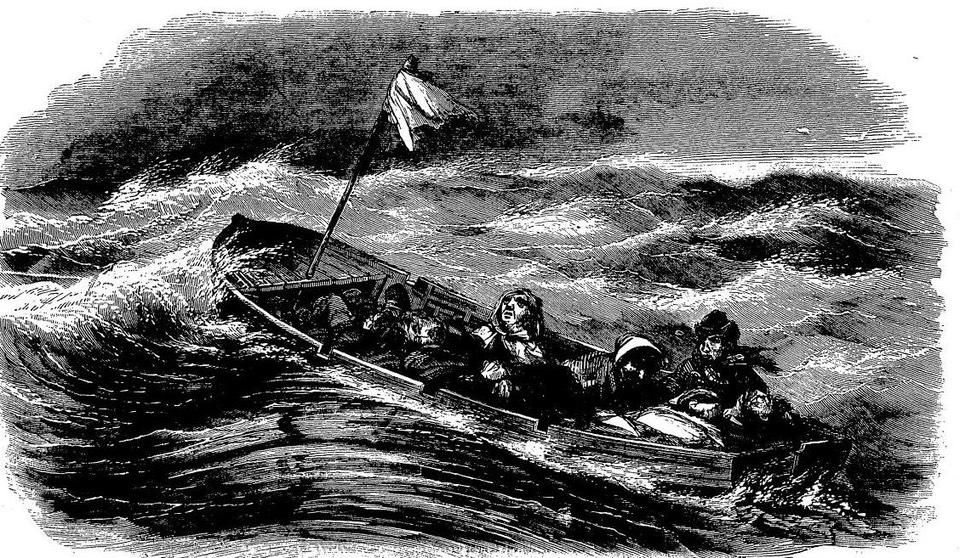When Thomas W. Nye died, newspapers told the story of a lifeboat off a foundering ship that hadn’t stood a chance without a compass, food, and water. Because Tom had been found adrift in this lifeboat it made him a newsworthy curiosity. But he was much more than that.
Tom was a passenger aboard the ship John Rutledge, which had already had more than its share of misfortune when she struck an iceberg some 300 miles west of Prince Edward Island and sank. She had sailed from Liverpool on January 16, 1856, bound for New York with a cargo of iron, salt, crockery, a crew of 26, and 121 passengers. The weather had been dreadful from the start and grew worse as the days passed. Gale force winds blew a crewman out of the ship’s rigging, and high seas washed a passenger overboard. Both were never seen again. As the ship clawed westward, seas grew even stormier as the warmth from the south and freezing air from the north whipped already high winds to hurricane strength. The ship plunged down troughs so cavernous that the walls of water fore and aft blotted out the sky as a scudding foam streaked sails. She struggled to climb a mountain of ocean, teetered on its crest, and then fell with a sickening and terrifying acceleration down into the next trough.
Even as bad as it was, it was merely an amplification of the foul weather that was seasonal for the North Atlantic in winter. Captain Alexander Kelley was used to it. He skillfully managed the ship and did his best to calm terrified passengers. Kelley wasn’t worried about the high winds and towering seas, but he was quite anxious about what mariners had always feared in that part of the world at that time of year.
The end of winter meant free-floating ice. The frozen sheets off the Newfoundland Banks became a mortal danger to navigation as the warm Gulf Stream caused calving on the ice shelf. Icebergs then drifted south into sea lanes. Some were enormous, as large as a fair-sized city, with the only certainty being that for every bit of berg above the water, as much as ten times more lay below it, stretching out just below the surface for thousands of yards.
Icebergs did not seem to move, but actually they slowly drifted southward — stately, majestic, impervious — and they posed fatal perils to a ship making way. A large iceberg’s massive size made it almost immortal, durable in warm water and treacherous even in lower latitudes. A prudent captain steering south would be scorned as fainthearted because he was merely lengthening his voyage without avoiding any perils. Kelley was a Centerville, Massachusetts, man, had gone to sea years earlier, before his voice had changed in fact, and was anything but fainthearted. He was not surprised when the John Rutledge encountered ice on February 18. It was part of the trip.
Seas continued rough with winds fresh, so Kelley shortened sail to slow down the ship as she entered an extensive ice field the following day. When he saw a clear way to open water, he made sail again to increase the ship’s speed. She was moving along at a brisk clip when the most astonishing thing happened.
The John Rutledge stopped. She didn’t grind to a halt and wallow in the waves after scraping against something. She stopped. She stopped dead in the water so abruptly that her stocky first mate, a Pennsylvania man named Atkinson, went sprawling on the deck. Passengers below slammed against bulkheads or fell into jumbles. The masts strained forward, visibly bending, spars cracking, and shrouds going taut — the sound of wood warping to the point of breaking filled the air with a low moan. It was then that the John Rutledge began wallowing in the rough water. She also started to pitch downward at her bow, rapidly.
There was no doubt that she had hit an iceberg, and the downward list of the bow indicated water was rushing into her forecastle. Passengers and crew operated the pumps and struggled with cargo to bring it up from the hold and throw it overboard. Salt and crockery were manageable, but the iron at midships was too heavy to budge, and it was the main culprit. The cargo they were able to remove, however, did reveal the damage to the hull, and it convinced captain and crew that the John Rutledge was lost. The pumps couldn’t keep up. It was after twilight that Kelley gave the order to abandon ship.
There were five lifeboats, which required that each carry at least 29 people. That number would have overloaded every boat. (The stark fact was that no ships carried enough lifeboats to accommodate every person aboard. It was the situation until the Titanic disaster 56 years later finally compelled a change in maritime regulations.)
How many people managed to board the first four boats is impossible to say, but they were likely overburdened and in grave peril because of the rough seas. We do know that each had a compass and at least one crew member in command with a reasonable amount of food and water if both were correctly rationed. The last of the lifeboats, however, was being loaded under exceptionally trying conditions, and it’s all but certain that at least 25 people, and by some counts 40, were left behind on the sinking ship.
It didn’t matter to the people who did climb into the fifth boat, and not because they were callous. Whether they stayed aboard a foundering ship or threw away their lives in the little boat pitching wildly at its tethers was merely a matter of choosing one’s poison. As 22-year-old Tom Nye stepped off the deck of the John Rutledge into the fifth boat, he knew he was going to die. It wasn’t just the darkness beyond the pale reach of swinging lanterns. It wasn’t just the weather, which was brutally cold, or the seas, which were churning under a freshening wind that sent icy foam flying through the air. It was the chaos that began to disrupt the proceedings as the boat bounced and banged against the hull of the dying ship.
The burly first mate Atkinson and the ship’s carpenter were supposed to board the boat, but they suddenly darted back from the rail. They shouted that they were going to check the ship’s pumps. That made no sense. The vessel was sinking. They had picked their poison.
Captain Kelley standing off in a lifeboat within hailing distance began frantically shouting for Tom and his companions to cast off unless they were to founder with the John Rutledge. Atkinson hadn’t made it aboard, but his wife, a large, robust woman, threw herself into the boat. She landed on its compass and shattered it. The fifth boat would have no way to get its bearings in starless nights or under heavy overcasts.
Haste meant that only the crewmen were warmly clothed while it prevented a proper loading of provisions, another bit of bad luck. They had only a gallon of water and about seven pounds of bread. Tom took stock: in addition to him, the boat held nine other passengers — four men, four women, and a little girl. There was also a Scottish sailor, Mrs. Atkinson, and the John Rutledge’s boatswain. Tom counted thirteen in all.
More bad luck, but none of it mattered. Tom Nye knew that they were all going to die.
Mrs. Atkinson claimed that her status as the absent mate’s wife placed her in command, and she commandeered the bread and water, ostensibly to ration it. But she and the boatswain guzzled down almost all the water that night and neglected the bread. High seas turned it into a sodden and useless mess.
The worst lay ahead. As much as there had been a plan in the pandemonium of leaving the John Rutledge, it was for the boats to stay together. The four that had gotten off earlier, all with compasses, could lead the way south to warmer water. At daybreak on February 20, however, none of the other four boats was in sight. Meanwhile, the fifth boat drifted aimlessly in the tumultuous sea.
The men occasionally pulled on the oars, but only to keep warm, and they soon gave up as the bitter cold closed in. Hunger and thirst gripped everyone. On the third day, they had the first casualty, a woefully underdressed male passenger. They lowered him over the side.

On the fourth day, they were putting the corpse of a woman over the side when they spotted sails to the south and soon made it out to be a ship heading east. It seemed near, and all pitched in at the oars pulling with all their might, but the brig gradually pulled away. They slumped on the oars catching their breath for what seemed an eternity. When they gathered their senses, all hope had been drained from the faces of the women, and the men seemed to sink in on themselves.
Tom drifted off in a fitful sleep, but the pitching boat violently awoke him with a start. He saw the others cupping their hands over the side and bringing them to their mouths. “No!” he shouted, “Don’t!” But he couldn't stop them from drinking seawater. After a while, he too scooped some of the frigid ocean into his mouth. He was at the point of swallowing when something made him gag, and he spat it out. Instead, he licked the ice that freezing rain formed on the boat’s rails.
He began doing this often. His boat mates, on the other hand, started to go mad. After a day of drinking seawater, a man named Henderson pulled his wife’s hair out in great handfuls. She passively let him. Mrs. Atkinson foamed at the mouth and begged for water with her hands clawing the air. Her partner in gluttony, the boatswain, became violent, threw the bailing bucket overboard, and struck Tom a blow on his chin that made him see stars.
Nobody was sorry to see these two die, but the exertion of lifting them and others over the rail into the sea tired out the five souls yet alive, Tom included. It was the eighth day, and by then, his companions were too muddled even to continue drinking the seawater that had deranged them. He watched listlessly as these last people died. In the end, the little girl went to sleep, and her mother curled up beside her and stopped moving. Tom didn’t have the strength to put any of them overboard.
It was all he could do to wedge into place a small staff with a red handkerchief tied on its top. He collapsed into unconsciousness. The boat’s wild motions from another storm did not wake him.
Tom Nye had no idea how long he had been unconscious when he opened his eyes. For an instant, he didn’t know where he was, but the four grotesque and distorted corpses in the boat reminded him. It was daylight, and he was foggily reckoning that it was probably the ninth day since the wreck when he saw a cruel mirage. For all the world it looked like a ship. He watched in wonder as another smaller vessel came nearer, and he heard a voice calling across the water, “Ahoyyyyy therrrrrre?” He was too weak to answer, but he soon heard splashing oars and felt something bump against the side of his lifeboat. A voice gasped, “Oh God in Heaven!”
Tom Nye croaked, “For the love of Jesus Christ, take me off of here.”
Nobody was blasphemous. The sailors from the SS Germania who looked into the fifth boat from the John Rutledge would never sleep soundly again. They laid on their oars with a will to pull themselves and Nye’s boat to their ship. Captain Daniel Wood directed the boy be brought aboard as gently as possible. The Germania’s crew was tempted to cut the lifeboat loose, but officers surveyed the ice field to the north and thought it might come in handy. There was also the matter of tending to the dead. The corpses were lowered over the lifeboat’s side as Captain Wood read from a Bible into the shrieking wind. Afterward, the crew scrubbed out the fifth boat and brought it aboard.
Wood’s ship had taken a beating from the same storms that had tormented the dwindling survivors of the John Rutledge, but he was determined to find the other four lifeboats that Tom Nye was whispering about. As the Germania commenced this errand, the ship’s steward and the captain’s wife cut away Nye’s clothes. The steward prepared the knives. It was clear that the lad’s frozen legs and arms were mortified to his thighs and above his elbows.
Tom heard the steward say, “They’ll have to come off.” He heard Mrs. Wood earnestly whispering to the steward and her husband. He felt them preparing him. After a brief pause, almost unbearable pain shot up from his legs.
By the time this good ship and its splendid people reached New York on March 23, Tom was taking solid food and sitting up. His mind gradually cleared, so he understood when Captain Wood came to tell him that they had searched for almost two weeks, but the other boats from the John Rutledge could not be found. There were no other survivors. Captain Wood was careful about telling Tom this. Mariners will know why.
They gave him time in New York to gain strength before putting him aboard the steamer Potemski for Boston, and from there he was gently conveyed to his home in New Bedford. A Fairhaven physician took over his case, and by the end of April, he had Tom Nye standing. In another few weeks, he started walking. Because, you see, while the Germania was looking for survivors from the John Rutledge, Mrs. Wood was hard at work.
The pain he had felt that first night aboard the Germania wasn't from a knife. Mrs. Wood had poured icy seawater over his legs and arms hour after hour, and then she had applied poultices made of bran and fresh milk drawn from the ship’s cow. She had replaced them frequently. She had not slept. After a full day and a half of Mrs. Wood’s ceaseless nursing, Tom Nye’s arms and legs were spared amputation.
Over the years, Tom was occasionally the subject of newspaper feature stories that increasingly got many of the facts wrong, the names incorrect, and the numbers skewed, but the story was just too good to let alone, despite its particulars being almost too fantastic to believe. Doubtless never a day passed that Thomas W. Nye did not think about his nine-day ordeal. He never talked about it, but it’s likely that he often wondered why he, rather than any of the others, survived. It would have been peculiar for him not to ponder these matters.
Meanwhile, and despite his horrible memories of the sea, he served in the US Navy during the Civil War. Afterward, he was the constable of his Massachusetts township. Along the way, he married and had children, and they, in turn, gave him numerous grandchildren. His was the life of a quiet hero in service to his country and community, a good neighbor going about the mundane but glorious business of loving a family and seeing to its shelter and safety.
When he died in 1905 at 71, he was a newsworthy curiosity because of his ordeal in the fifth boat a half-century before. But as we noted at the beginning of our story, Tom Nye was more than that. He spoke little if at all of the nightmare that defined him for the world, but the way he lived suggests he saw himself as neither a victim nor a survivor. His time in the fifth boat was not the end of his life nor the sum of it. Rather, the boat had been the palm of something larger and unfathomable that kept him alive on storm-tossed seas for nine days, and then, in other forms, for nearly fifty years afterward. The fifth boat had allowed him to be rescued and also to be saved.
Those two are not the same thing. Tom Nye certainly pondered these matters.



